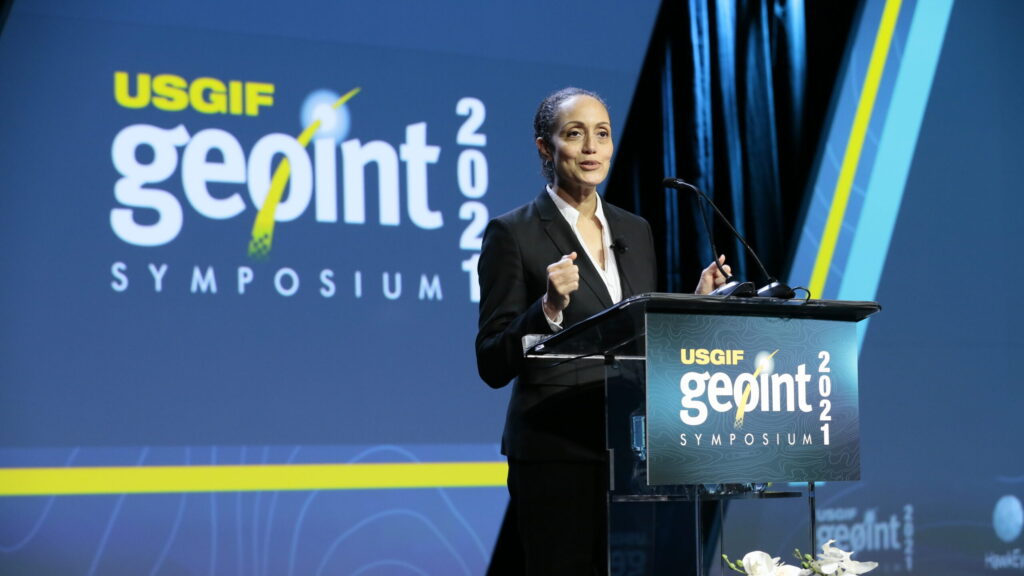
Principal Deputy Director of National Intelligence Stacey Dixon (USGIF staff)
GEOINT 2021: The Intelligence Community (IC) and key policy-makers within the Biden administration are intensifying efforts to reduce regulatory burdens and encourage more competition in the commercial remote sensing satellite marketplace, said Stacey Dixon, deputy director of national intelligence.
While she provided few specifics about plans in her address to the annual GEOINT conference today, she did say that in their deliberations on the way forward, government officials are looking to the model of streamlined space launch licensing practices. Regulatory reform has freed the launch industry in a way that has allowed prices to loft satellites to orbit to drop dramatically, she explained, and there is a thriving ecosystem of American companies competing for business.
“It is important to realize and recognize that there’s a growing consensus, not only in the IC but also among policy-makers, that the kind of change that we’ve seen in launch services is the right way to go in other areas,” Dixon said at the conference hosted by the United States Geospatial Intelligence Foundation (USGIF). “And this is because there was a recognition that the competitive environment is rapidly changing. And in this new environment, American industry must continue to lead.”
RELATED: To Advance GEOINT Research, Intel Community Seeks Help Outside Government
She asserted that the US government must adapt the way it does business in the remote sensing arena — which has resulted in a situation where “American companies have been constrained by a commercial licensing process that for many has been slow and opaque and felt burdensome” — to face growing challenges and threats from competitors such as China.
“If we don’t adapt, others will set the rules and challenge our new leadership. We should set the rules. We should influence the standards, and do so in a way that is consistent with our democratic values,” Dixon said.
The threats and challenges are not simply in the military arena, she explained, but also in the private sector sphere.
“We understand that foreign competitors are numerous and growing. This includes growth among our allies and friends, but also growth in those countries where [lines between] public and private, and especially civilian and military, are more blurred or non-existent,” Dixon said. “In our analysis, some of these companies are closing the gap, creating security concerns, and winning private sector business that could be yours.”
RELATED: Commercial GEOINT Raises Questions About NGA, IC Roles: Gordon
She noted that recently the Office of the Director of National Intelligence (ODNI) set about creating a coordination mechanism for all the IC actors involved in space “to speak with a unified voice” in working with the Departments of Defense, State and Commerce on remote sensing issues. Further, the IC is “increasingly integrating industry voices into our deliberations” to better understand and address commercial company needs.
“We want to pare down the constraints you face to only those that are absolutely necessary, particularly when it comes to competing on capabilities that are commercially available from others,” Dixon told the largely industry GEOINT audience. “While lifting some restrictions will not be possible, because custom and classified GEOINT capabilities are still critical to helping us understand and confront core national security challenges, it should be possible to provide a unified clear response that will allow you to make the investments you need and want to make more quickly.”
Dixon’s words were no doubt music to the ears of the commercial remote sensing industry, which has been concerned that the Intelligence Community under the Biden administration might backslide on the previous administration’s regulatory reform push.
In particular, a number of industry players have been worried that the National Reconnaissance Office is keen to reverse licensing reforms made by the Commerce Department last May that freed up US firms to sell very high resolution images if equivalent imagery is available on the international market. Those fears were stoked by the office’s release in June of a draft request for proposals (RFP) for commercial imagery program, known as the Electro Optical Commercial Layer (EOCL), obtained by Breaking Defense in July.
The final RFP has not yet been released, but as Space News reported yesterday, the draft is currently being reviewed by the IC (including DoD) and is expected by the end of the year.
Space Force EW unit working to integrate new weapon systems, intel personnel
The Space Force’s Delta 3 is responsible for organizing, training and equipping Guardians for electronic warfare missions involving satellite communications, as well as sustaining related offensive and defensive EW systems.



























